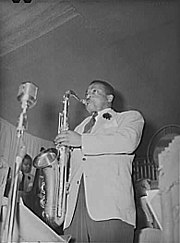Ben Webster's Human Design Chart
3/5 Sacral Manifesting GeneratorAmerican jazz tenor saxophonist, a.k.a. “The Brute” or “Frog.”
Webster was considered one of the three most important “swing tenors” along with Coleman Hawkins and Lester Young. Known affectionately as “The Brute”, he had a tough, raspy, and brutal tone on stomps (with his own distinctive growls), yet on ballads he played with warmth and sentiment. Stylistically he was indebted to alto star Johnny Hodges, who, he said, taught him to play his instrument.
Webster spent time with quite a few orchestras in the 1930s, including Andy Kirk, the Fletcher Henderson Orchestra in 1934, then Benny Carter, Willie Bryant, Cab Calloway, and the short-lived Teddy Wilson big band.
Playing with Duke Ellington’s orchestra for the first time in 1935, by 1940 Ben Webster had become its first major tenor soloist. He credited Johnny Hodges, Ellington’s alto soloist, as a major influence on his playing. During the next three years he was on many famous recordings, including “Cotton Tail” and “All Too Soon”; his contribution (together with that of bassist Jimmy Blanton) was so important that Ellington’s orchestra during that period is known as the Blanton–Webster band. Webster left the band in 1943 after an angry altercation, during which he allegedly cut up one of Ellington’s suits.
In 1953 he recorded King of the Tenors with pianist Oscar Peterson, who would be an important collaborator for Webster throughout the decade. Coleman Hawkins Encounters Ben Webster with fellow tenor saxophonist Coleman Hawkins was recorded on December 16, 1957 along with Peterson, Herb Ellis (guitar), Ray Brown (bass), and Alvin Stoller (drums). The Hawkins and Webster recording is a jazz classic, the coming together of two giants of the tenor saxophone, who had first met back in Kansas City.
Webster generally worked steadily but in 1964 he moved permanently to join other American jazz musicians in Europe, where he played when he pleased during his last decade. He lived in London for one year, followed by four years in Amsterdam and made his last home in Copenhagen in 1969.
Webster suffered a cerebral hemorrhage in Amsterdam, North Holland, in September 1973, following a performance at the Twee Spieghels in Leiden, and died on the 20th.
Link to Wikipedia biography
Discover More Famous People
Browse and analyze over 55,000 public figures and celebrities.
Ra Uru Hu
5/1 Manifestor
Martha Stewart
4/6 Manifestor
David Lynch
4/6 Generator
Barack Obama
6/2 Projector
Steve Jobs
6/3 Generator
Vladimir Putin
5/1 Manifestor
Kim Kardashian
3/5 Generator
Michael Jackson
1/3 Projector
Marilyn Monroe
6/2 Projector
Ariana Grande
2/4 Projector
Oprah Winfrey
2/4 Generator
Johnny Depp
2/4 ManifestorWhat is HumanDesign.ai and how does it work?
Curious what makes Ben Webster tick? HumanDesign.ai instantly maps their exact birth data into a fully interactive clickable bodygraph chart, letting you hover or tap every center, channel, and gate for plain-language explanations. Bella, the platform’s built-in AI guide, adds context in real time, translating complex mechanics into everyday insights so you can see how Ben Webster’s strengths, challenges, and life themes play out on-screen.
The same tools are waiting for you. Generate your own Human Design Chart in seconds, open a library of 2000+ suggested questions, and chat with Bella as often as you like to decode your design, daily transits, and even relationship dynamics.
Want to compare energies? Save unlimited charts for friends, family, or clients, then ask Bella to reveal compatibilities, composite patterns, or coaching tips, all in one conversation thread.
Start free with core features, or unlock our Personal and Pro plans for deeper dives: unlimited Q&A, celebrity chart search spanning 55,000+ public figures, white-label PDF reports, branded content generation, and a professional profile with built-in booking for practitioners. Whether you’re exploring your own potential or guiding others, HumanDesign.ai delivers an ever-expanding toolbox of AI-powered insights—no spreadsheets, no jargon, just clarity at your fingertips.
Ready to see yours? Signup for FREE today!

